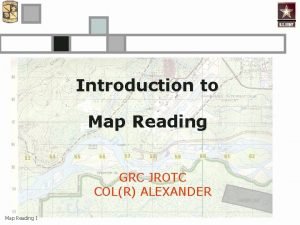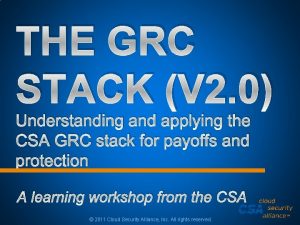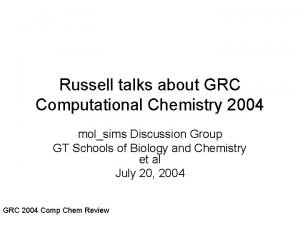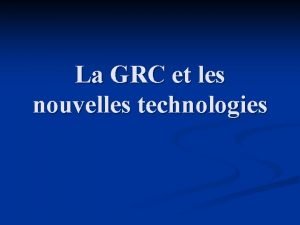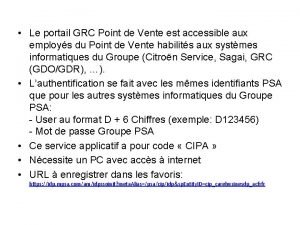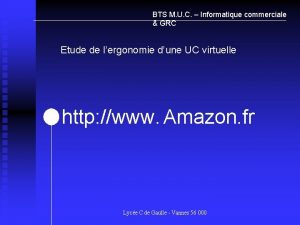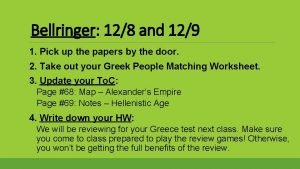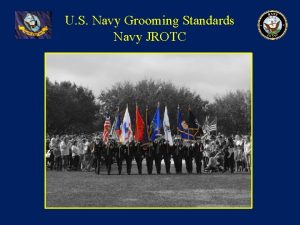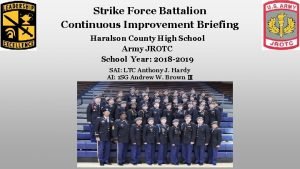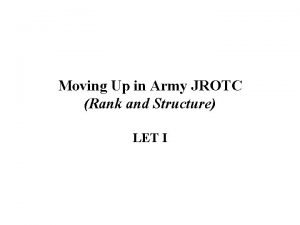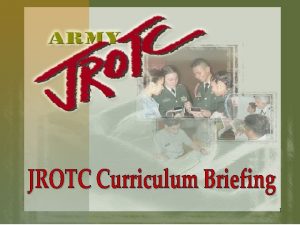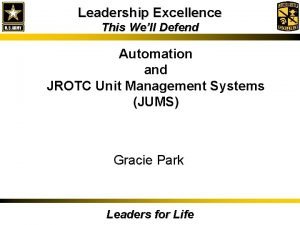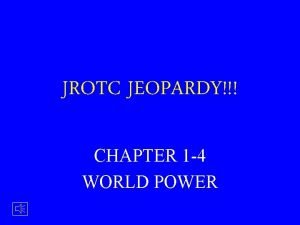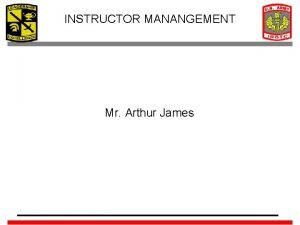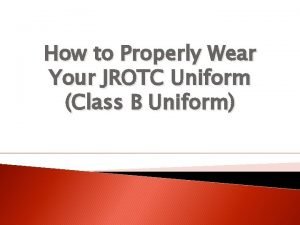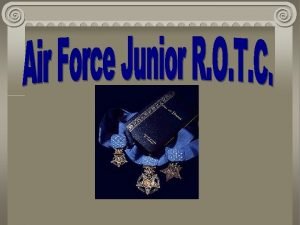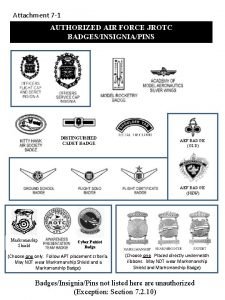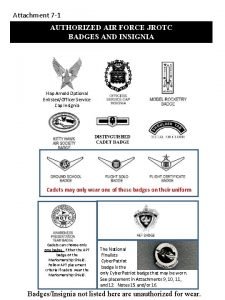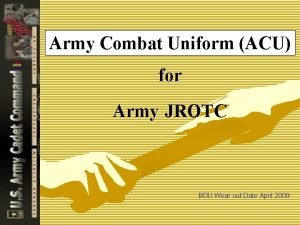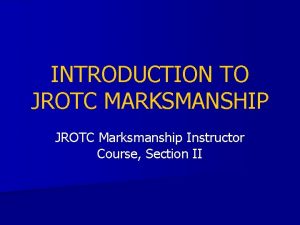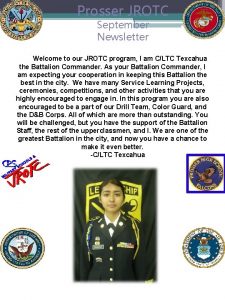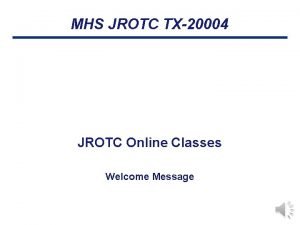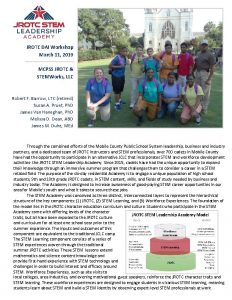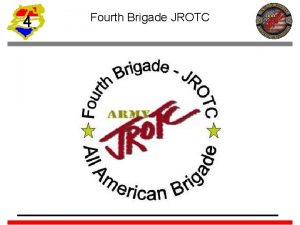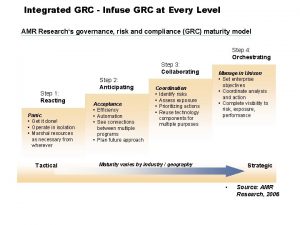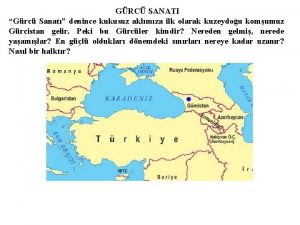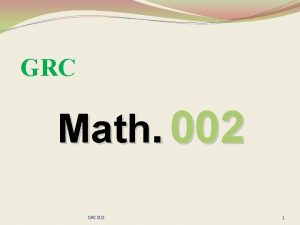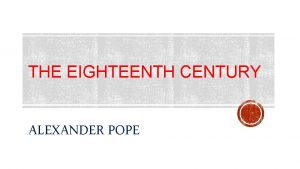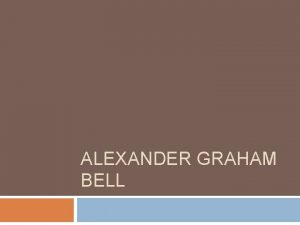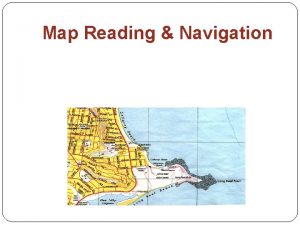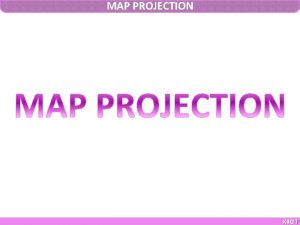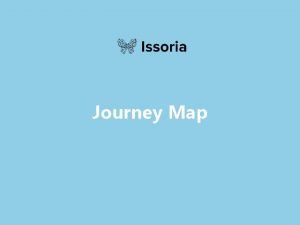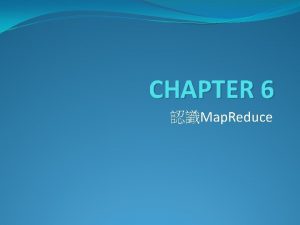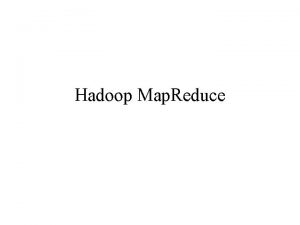Introduction to Map Reading GRC JROTC COLR ALEXANDER








































- Slides: 40

Introduction to Map Reading GRC JROTC COL(R) ALEXANDER Map Reading I

Outline Purpose n Objectives n Marginal Information n Colors n Terrain Features n Conclusion n Map Reading I

Purpose To lay the groundwork for successful map reading and land navigation by exposing the cadet to basic information, significant color coding, and terrain features used on maps. Map Reading I

Objectives n Become familiar with marginal information on a map sheet. n Identify topographic symbols on a military map. n Identify the five (5) major, three (3) minor and two (2) supplemental terrain features on a map. n Determine grid coordinates on a map. Map Reading I

Margin Information n Sheet Name: n Sheet Number: n Adjoining Map Sheets Diagram: Map Reading I

Margin Information n Special Notes: n Declination Diagram: Map Reading I

Margin Information n Scales: n Contour Interval Notes: n Grid Reference Box: Map Reading I

Margin Information n Unit Imprint: n Legend: Map Reading I

Topographic Symbols Map Reading I

Colors (x 6) n BLACK: Man-made features (Buildings, roads, grid-lines) n RED-BROWN: cultural features (contour lines) n BLUE: Water features (Lakes, swamps and rivers) n BROWN: Relief features and elevation on older or red-light readable maps (contour lines and cultivated land) n GREEN: Vegetation (forest, woods, brush, orchards) n RED: Man-made features (populated areas, major highway roads, boundaries on older maps) Map Reading I

Topographic Symbols: Blue Map Reading I

Topographic Symbols: Green Map Reading I

Contour Lines & Interval (Brown or Red-Brown) 1. Check contour interval 2. Find given elevation 3. Determine direction of slope 4. Count contour intervals. Change in ELEVATION Map Reading I

Contour Lines & Interval Lines that are farther apart (interval) = GENTLE SLOPE Map Reading I

Contour Lines & Interval Lines that are close together (interval) = STEEP SLOPE Map Reading I

Major Terrain Features (x 5) 1. 2. 3. 4. 5. Map Reading I Hill. Valley. Ridge. Saddle. Depression. H idden V alley R anch S alad D ressing

Major Terrain Features 1 of 5 Hill: An area of high ground X - Concentric circles. The center of the smallest circle is the hilltop. Map Reading I

Major Terrain Features 3 of 5 Valley: a stretched‑out groove in the land, usually formed by streams or rivers. - U or V shaped contour lines. High ground on 3 sides usually with water flowing in the middle. V or U points upstream. Map Reading I

Valley Map Reading I

Major Terrain Features 4 of 5 Ridge: This is a sloping line of high ground. - low ground in three directions and high ground in one direction. Contour lines tend to be U‑shaped or V‑shaped. The closed end of the contour line points to lower ground Map Reading I

Ridgeline Map Reading I

Major Terrain Features 2 of 5 Saddle: Low point between 2 areas of high ground X - hour glass or figure eight contour lines. Map Reading I

Saddle Map Reading I

Major Terrain Features 5 of 5 Depression: This is a low point in the ground. - Low ground or sink hole. Closed contour lines that have tick marks pointing toward low ground. Map Reading I

Depression Map Reading I

Minor Terrain Features (x 3) 1. 2. 3. Map Reading I Draw. Spur. Cliff.

Minor Terrain Features 1 of 3 Draw: a less developed stream course than a valley. There is essentially no level ground. contour lines depicting a draw are U‑shaped or V‑shaped, pointing toward high ground. Map Reading I -

Minor Terrain Features 2 of 3 Spur: a short, continuous sloping line of higher ground, normally jutting out from the side of a ridge. - Contour lines depict the U or V pointing away from high ground. Map Reading I

Spur & Draw Map Reading I

Minor Terrain Features 3 of 3 Cliff: a vertical or near vertical feature. - Contour line converge together into one “Carrying” contour. The last contour has tick marks pointing towards low ground. Sometimes depicted by contours running very close or touching. Map Reading I

Cliff Map Reading I

Supplementary Terrain Features (x 2) 1. 2. Map Reading I Cut. Fill.

Supplementary Terrain Features Cut or Fill: a man‑made feature resulting from cutting through high ground or filling low ground. - Contour line extends the length of the cut (tick marks point to roadbed) and fill (tick marks point away from roadbed). Map Reading I

Practical Exercise 8 9 6 6 1. 2. 3. 4. 5. 6. 7. 8. 9. 10. Map Reading I

Practical Exercise Key 1. HILL 2. VALLEY 3. RIDGE 4. SADDLE 5. DEPRESSION 6. DRAW 7. SPUR 8. CLIFF 9. CUT 10. FILL Map Reading I

HILL RIDGE SADDLE SPUR DRAW X Map Reading I

Identify the TERRAIN FEATURE of the CIRCLES Map Reading I

Summary Purpose n Marginal Information n Colors (x 6) n Terrain Features n n Map Reading I Major Minor Supplementary

Conclusion Knowing how to read and understand maps are valuable skills that can strengthen your awareness, credibility as a leader, and help you standout among your peers. Map Reading I

Introduction to Map Reading GRC JROTC COL. ALEXANDER Map Reading I
 Major terrain features
Major terrain features While reading activities
While reading activities Forrester identity management and governance
Forrester identity management and governance Grc stack
Grc stack Grc computational chemistry
Grc computational chemistry Objectif conatif exemple
Objectif conatif exemple D365 fo grc
D365 fo grc Grc roadmap
Grc roadmap Microsoft nav china
Microsoft nav china Portail grc
Portail grc Oracle governance risk and compliance
Oracle governance risk and compliance Grc crm
Grc crm Informatique bts muc
Informatique bts muc Grc meaning
Grc meaning Grc transformation in banks
Grc transformation in banks Phalanx grc
Phalanx grc Tm for oe 254
Tm for oe 254 Alexander the great map activity
Alexander the great map activity St. louis
St. louis What are the aims of teaching reading
What are the aims of teaching reading Kind of reading
Kind of reading Edb net section
Edb net section It involves scrutinizing
It involves scrutinizing Intensive reading and extensive reading
Intensive reading and extensive reading For adult
For adult How to develop reading skills in students
How to develop reading skills in students Jrotc girl hair
Jrotc girl hair Bravo company motto ideas
Bravo company motto ideas Jrotc nedir
Jrotc nedir Core abilities
Core abilities Army jrotc jums
Army jrotc jums Jrotc jeopardy
Jrotc jeopardy Jcims
Jcims Jrotc creed army
Jrotc creed army Female jrotc uniform class b
Female jrotc uniform class b Afjrotc ribbons
Afjrotc ribbons Air force jrotc ranks
Air force jrotc ranks Air force jrotc ranks
Air force jrotc ranks Army jrotc acu
Army jrotc acu Afjrotc distinguished cadet badge
Afjrotc distinguished cadet badge Marksmanship instructor
Marksmanship instructor
